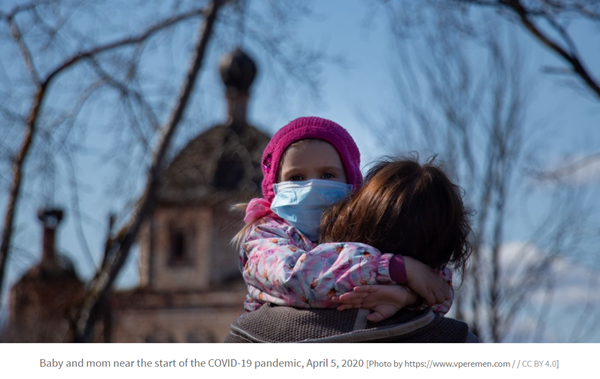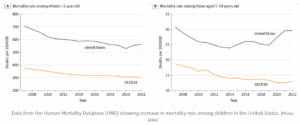Death rate for US children surges 25 percent in 10 years
By Benjamin Mateus, Evan Blake
August 15, 2025
 The death rate for US children has surged by 25 percent over the past decade, according to a study published last month by pediatrician Dr. Christopher Forrest and colleagues in the Journal of the American Medical Association. Even as the child mortality rate has slowly fallen in other developed countries, it has surged in the US, along with every other indicator of chronic illness.
The death rate for US children has surged by 25 percent over the past decade, according to a study published last month by pediatrician Dr. Christopher Forrest and colleagues in the Journal of the American Medical Association. Even as the child mortality rate has slowly fallen in other developed countries, it has surged in the US, along with every other indicator of chronic illness.
The research underscores the American ruling elites’ complete disregard for children’s well-being and safety, especially for the children of the working class.
In 2014, US children were about 1.6 times more likely to die than their counterparts in peer countries. By 2022, that gap had widened dramatically: American children were now 2.3 times as likely to die.
The authors estimated that between 2007 and 2022, an additional 316,000 US child deaths were attributable to the gap in mortality compared to other developed countries. This is equivalent to a staggering 54 excess child deaths per day in the US.

From 2011 to 2023, the prevalence of children aged three to 17 with chronic conditions rose from 39.9 percent to 45.7 percent within the healthcare systems studied. US children aged 1 to 19 were 15.3 times more likely to die from firearms compared to their peers in other developed nations, with these rates steadily rising over the study period. In 2020, firearm mortality overtook motor vehicle crashes as the leading cause of death in US youth.
The study also documented alarming trends in mental health and chronic conditions. Major depression among children increased by 230 percent from 2010 to 2023, while sleep apnea tripled, eating disorders increased by 220 percent, and childhood obesity rates rose from 17 percent in 2007-2008 to 20.9 percent in 2021-2023.
For infants under age one, respiratory infections, prematurity, congenital anomalies and sudden unexpected infant deaths were common factors in their demise, speaking to the broader issue of maternal healthcare and medical issues surrounding childbirth in the US. The US mortality disadvantage was driven largely by sudden unexpected infant death and prematurity—conditions directly linked to inadequate prenatal care, maternal health disparities and poverty. US infants were 2.2 times more likely to die from prematurity and 2.4 times more likely to die from sudden unexpected infant death compared to peer countries.
These statistics reflect the systematic destruction of the social infrastructure necessary to support child development and health.
In a companion editorial to the study, titled “How we are failing US children,” Dr. Elizabeth Wolf of Virginia Commonwealth University and colleagues explained that these systemic problems creating disastrous conditions are all preventable and arise from negligence in addressing the welfare and well-being of the US population.
Five percent of US children lack insurance, while 40 percent of children with public insurance have limited access to primary and specialty care simply because the insurance system is rigged against reimbursement and primary care. There is a suffocating deficit of pediatric mental health professionals that cannot keep pace with demands, placing additional burdens on primary care clinics and emergency departments.
The editorial accompanying the study points to five domains that explain the US health disadvantage: healthcare, behaviors, socioeconomic conditions, the environment and public policies.
The US differs fundamentally from peer countries in each domain. The fragmented health insurance landscape provides little help for lower-middle class families and impedes continuous enrollment, while the US has among the highest child poverty rates and income inequality in the OECD.
Environmental factors compound these problems. Persistent underinvestment in childhood health programs limits youth access to health-promoting resources and increases exposure to health hazards. Low-income children have greater exposure to airborne pollutants that trigger asthma and are more likely to live near environmental hazards and high-speed roads without pedestrian safety features.
Much of the increase has occurred since the onset of the COVID-19 pandemic, underscoring not only the deadly nature of the pandemic but also the failed social and political response that has steadily eviscerated public health and healthcare.
The pandemic itself continues unabated, with more than 350 Americans still dying weekly from COVID-19 as of May 2025, and the US is now in the grips of its 11th wave of mass infection. Since the start of the pandemic, there have now been over 1.38 million excess deaths in the US, with the working class disproportionately affected.
Among children, an estimated 4 percent have now developed…
[READ THE COMPLETE ARTICLE HERE]
